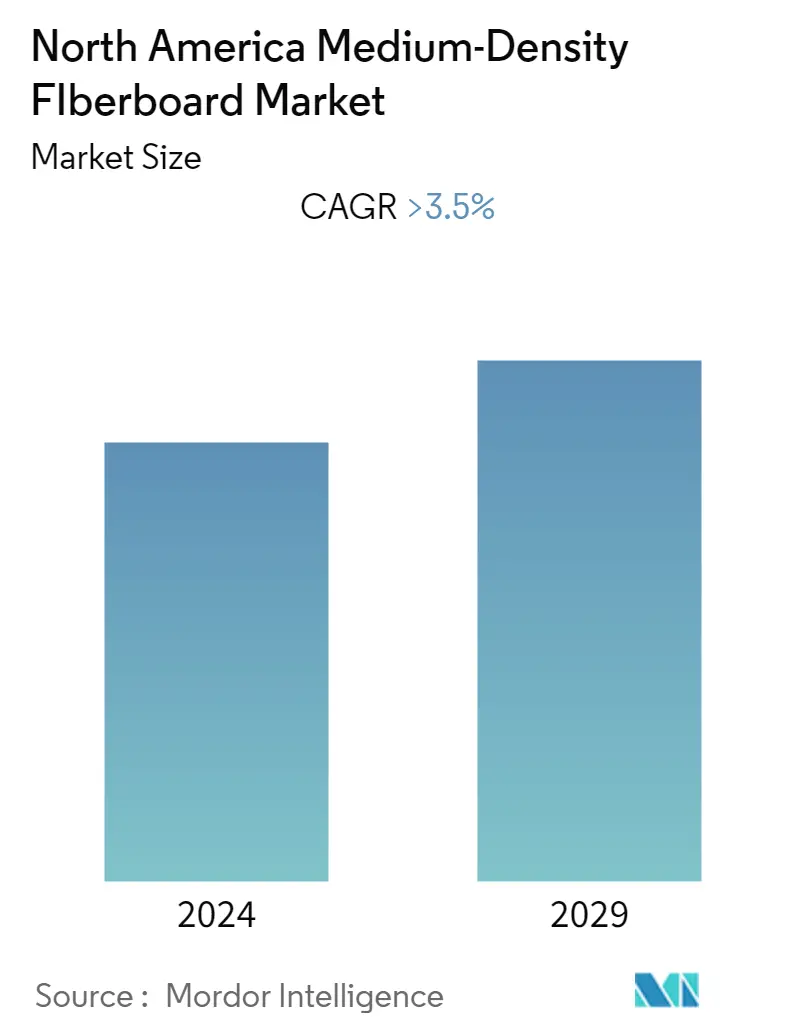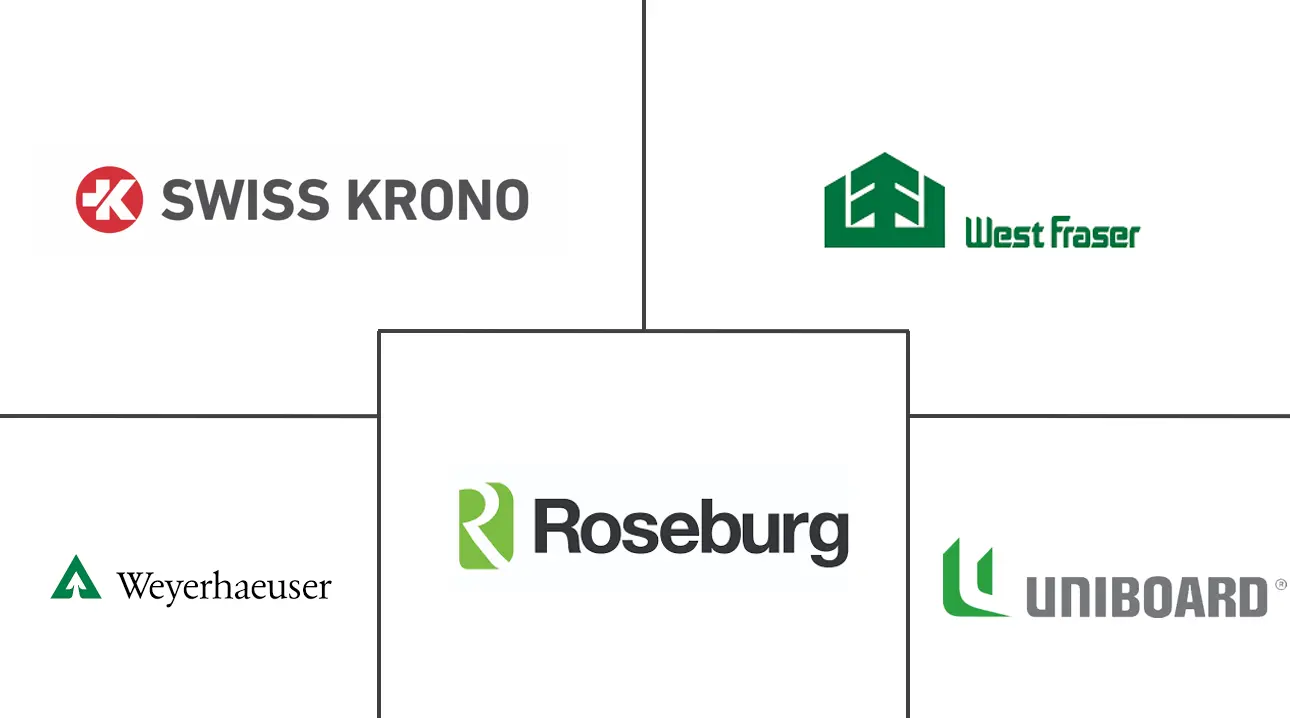Market Size of North America Medium-Density FIberboard Industry

| Study Period | 2019 - 2029 |
| Base Year For Estimation | 2023 |
| Forecast Data Period | 2024 - 2029 |
| Historical Data Period | 2019 - 2022 |
| CAGR | 3.50 % |
| Market Concentration | Low |
Major Players
*Disclaimer: Major Players sorted in no particular order |
North America Medium-Density FIberboard Market Analysis
The North American medium-density fiberboard (MDF) market is estimated to grow with a CAGR of over 3.5% during the forecast period.
The lockdowns and strict social distancing norms that followed the COVID-19 pandemic resulted in the shutdown of many manufacturing and construction activities and disruptions in the supply chain, which further hampered the demand for MDF in the market.
- With manufacturing and construction activities resuming back to the pre-pandemic levels, the demand for MDF is expected to ramp up during the forecast period.
- The easy availability of raw materials and the increase in demand for MDF in furniture applications are the two major factors driving the demand.
- However, stringent regulations by the government are likely to hinder the growth of the market studied.
- The United States is expected to dominate the North American region.
North America Medium-Density FIberboard Industry Segmentation
Medium-density fiberboard (MDF) is a reconstituted wood-based panel product. It is made by breaking down hardwood or softwood residuals into wood fibers, often in a defibrillator, combining it with wax and a resin binder, and forming panels by applying high temperature and pressure. MDF is used in varied applications ranging from the manufacture of various furniture to laminate flooring.
The North American medium-density fiberboard market is segmented by application and end-user industry. By application, the market is segmented into cabinet, flooring, furniture, molding, door and millwork, packaging systems, and other applications. By end-user industry, the market is segmented into residential, commercial, and institutional. By geography, the market is segmented into United States, Canada, and Mexico. The report covers the market size and forecasts for the North American medium-density fiberboard market in three countries across the North American region. For each segment, the market sizing and forecasts have been provided on the basis of volume (thousand cubic meters).
| By Application | |
| Cabinet | |
| Flooring | |
| Furniture | |
| Molding, Door and Millwork | |
| Packaging System | |
| Other Applications |
| By End-user Industry | |
| Residential | |
| Commercial | |
| Institutional |
| North America | |
| United States | |
| Canada | |
| Mexico |
North America Medium-Density FIberboard Market Size Summary
The North American medium-density fiberboard (MDF) market is poised for growth, driven by the resurgence of manufacturing and construction activities post-pandemic. The market is characterized by the easy availability of raw materials and a rising demand for MDF in furniture applications, which are key factors propelling its expansion. Despite the challenges posed by stringent government regulations, the market is expected to benefit from the superior stability of MDF compared to solid wood, making it a preferred choice for furniture, cabinetry, and flooring. The trend of increasing residential construction, fueled by population growth, urban migration, and the rise of nuclear families, further supports the demand for MDF in the region.
The United States holds a dominant position in the North American MDF market, largely due to increased export activities and consumer spending. The construction sector in the country is anticipated to grow steadily, enhancing the demand for MDF. The market is fragmented, with major players such as Roseburg Forest Products, Weyerhaeuser Company, and Swiss Krono AG actively participating. Recent developments, such as Roseburg's exploration of a new MDF panel plant and Alberta Biobord Corporation's plans to address the MDF market shortage, highlight ongoing efforts to meet the growing demand. These initiatives are expected to significantly contribute to the market's growth trajectory during the forecast period.
North America Medium-Density FIberboard Market Size - Table of Contents
-
1. MARKET DYNAMICS
-
1.1 Drivers
-
1.1.1 Increase in Demand for MDF in Furniture Making
-
1.1.2 Easy Availability of Raw Materials
-
-
1.2 Restraints
-
1.2.1 Stringent Government Regulations
-
-
1.3 Industry Value-Chain Analysis
-
1.4 Porter's Five Forces Analysis
-
1.4.1 Bargaining Power of Suppliers
-
1.4.2 Bargaining Power of Buyers
-
1.4.3 Threat of New Entrants
-
1.4.4 Threat of Substitute Products and Services
-
1.4.5 Degree of Competition
-
-
-
2. MARKET SEGMENTATION (Market Size in Volume)
-
2.1 By Application
-
2.1.1 Cabinet
-
2.1.2 Flooring
-
2.1.3 Furniture
-
2.1.4 Molding, Door and Millwork
-
2.1.5 Packaging System
-
2.1.6 Other Applications
-
-
2.2 By End-user Industry
-
2.2.1 Residential
-
2.2.2 Commercial
-
2.2.3 Institutional
-
-
2.3 By Geography
-
2.4 North America
-
2.4.1 United States
-
2.4.2 Canada
-
2.4.3 Mexico
-
-
North America Medium-Density FIberboard Market Size FAQs
What is the current North America Medium-Density FIberboard Market size?
The North America Medium-Density FIberboard Market is projected to register a CAGR of greater than 3.5% during the forecast period (2024-2029)
Who are the key players in North America Medium-Density FIberboard Market?
Roseburg Forest Products, Weyerhaeuser Company, Swiss Krono AG, West Fraser Timber Co. Ltd. and Uniboard are the major companies operating in the North America Medium-Density FIberboard Market.

